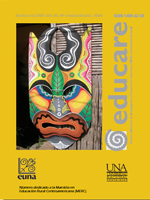Análisis de necesidades educativas curriculares en la educación primaria dirigida a niños (as) nicaragüenses migrantes en Costa Rica
DOI:
https://doi.org/10.15359/ree.12-Ext.4Keywords:
migrant children, migrant population profile, curricular needs of education for migrant childrenAbstract
The intention of the article is to announce the needs of a curriculum Identified in the Nicaraguan migrant children that study at the rural primary school “Los Angeles” in the location of Los Chiles Costa Rica. They actually are in an exclusion, discrimination and indifference situation from the local institutions. There are strong obstacles for the effective learning and development of positive attitudes, lack of responsible participation of the educative community; the methodological procedure used at the classrooms and the curricular adjustment at the pedagogical official model from Costa Rica, divorced those, from the sociocultural conditions of the children, their families and the rural community where they live.
This situation affects the children motivation, for not achieve educational goals, the few that register at primary school doesn´t end it and those that complete it have academic difficulties to enter at high school.
The time has come for the educational systems from both countries –Nicaragua and Costa Rica– to consider joint educational strategies that can give an answer to the educational curricular needs that the Nicaraguan migrant children presents at the rural schools in Costa Rica.
References
Castro, C. (2002). Migración nicaragüense en Costa Rica: población, empleo y necesidades básicas
insatisfechas. Costa Rica: Facultad Latinoamericana de Ciencias Sociales.
Comisión paara la Defensa de los Derechos Humanos en Centroamérica [CODEHUCA]. (2005).
Situación de la población migrante nicaragüense en Costa Rica. San José, Costa Rica.
Corea, A. (2006). Centro educativo Los Ángeles. Alajuela, Costa Rica: Dirección Regional de San
Carlos, Los Chiles.
Costa Rica. Ministerio de Planificación Nacional y Política Económica [MIDEPLAN]. (2005). Plan
Nacional de Desarrollo 2002-2006. Las iniciativas relativas al acceso a la educación y a la
formación. San José: Autor.
Fondo de las Naciones Unidas para la Infancia UNICEF’ (1989, noviembre). Convención sobre los
Derechos del Niño. UNICEF.
French, A. (2005). Informe: Los Derechos del niño en Nicaragua. Secretariado General-Oficina de
Asuntos Internacionales y Derechos Humanos. Consultado el 10 de juniode de: http:/www.
ochchr.org/english/bodies/crc/cres39.htm Ministerio de Educación de Costa Rica (2005).
Oficina de Estadística. San José, Costa Rica: Departamento de Estadística-MEP.
Downloads
Published
How to Cite
Issue
Section
License
1. In case the submitted paper is accepted for publication, the author(s) FREELY, COSTLESS, EXCLUSIVELY AND FOR AN INDEFINITE TERM transfer copyrights and patrimonial rights to Universidad Nacional (UNA, Costa Rica). For more details check the Originality Statement and Copyright Transfer Agreement
2. REUTILIZATION RIGHTS: UNA authorizes authors to use, for any purpose (among them selfarchiving or autoarchiving) and to publish in the Internet in any electronic site, the paper´'s final version, both approved and published (post print), as long as it is done with a non commercial purpose, does not generate derivates without previous consentment and recognizes both publisher's name and authorship.
3. The submission and possible publication of the paper in the Educare Electronic Journal is ruled by the Journal’s editorial policies, the institutional rules of Universidad Nacional and the laws of the Republic of Costa Rica. Additionally, any possible difference of opinion or future dispute shall be settled in accordance with the mechanisms of Alternative Dispute Resolution and the Costa Rican Jurisdiction.
4. In all cases, it is understood that the opinions issued are those of the authors and do not necessarily reflect the position and opinion of Educare, CIDE or Universidad Nacional, Costa Rica. It is also understood that, in the exercise of academic freedom, the authors have carried out a rogorous scientific-academic process of research, reflection and argumentation thar lays within the thematic scope of interest of the Journal.
5. The papers published by Educare Electronic Journal use a Creative Commons License:















 The articles published by Educare Electronic Journal can be shared with a Creative Commons License:
The articles published by Educare Electronic Journal can be shared with a Creative Commons License: 



